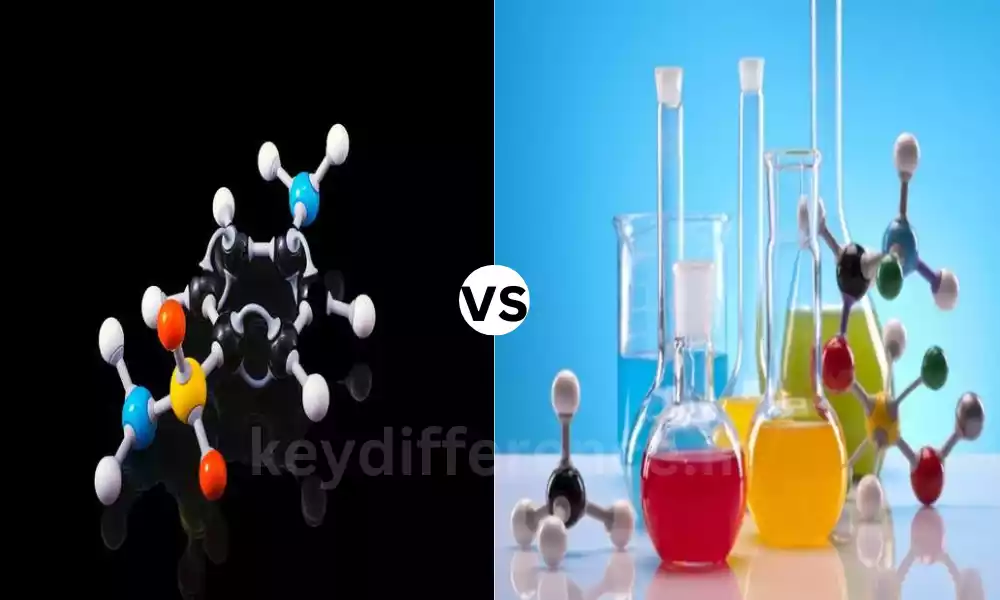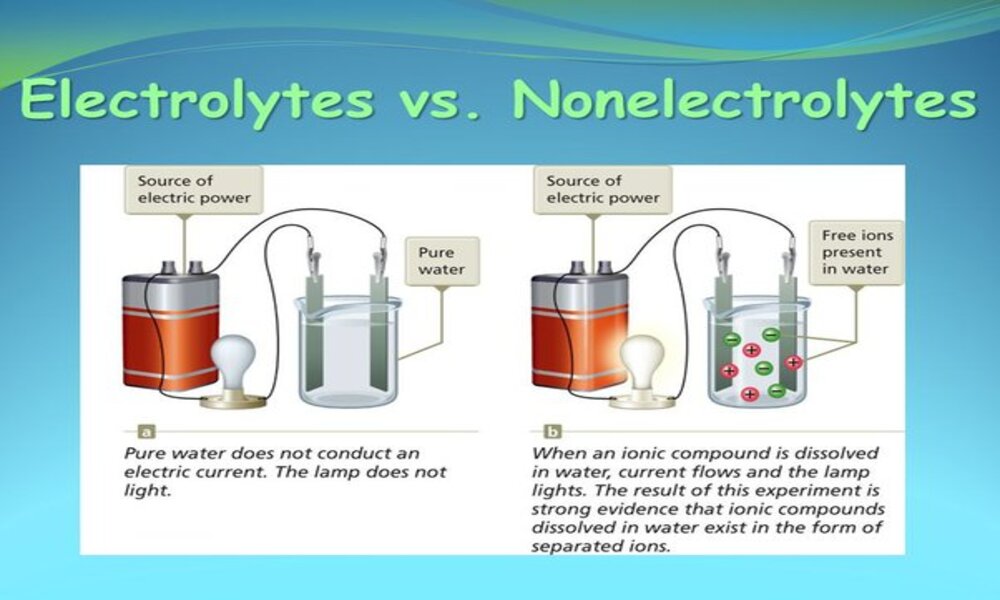“Organic and inorganic compounds form the cornerstone of chemistry, distinguishing themselves through fundamental differences in composition, structure, and properties.
Organic compounds, primarily consisting of carbon and hydrogen, are often associated with living organisms and complex molecular structures. Inorganic compounds encompass a broad spectrum of substances without carbon-hydrogen bonds, found abundantly in non-living matter.
Understanding their distinctions is pivotal, unraveling the diverse realms of biology, industry, and beyond.”
What is an Organic Compound?
Organic compounds are made up of hydrogen and carbon Atoms, which are often linked to other elements like sulfur, nitrogen, oxygen, and halogens. These substances are vital for living organisms and are integrally involved in the biological process.

They are the base of the various essential molecules that are found in nature, such as proteins, carbohydrates, lipids nucleic acids, and hydrocarbons.
Organic Chemistry focuses on the study of carbon-based substances, their structures and properties, their reactions, and their numerous applications in fields such as agriculture, medicine, industry, and sciences of materials.
What is an Inorganic Compound?
Inorganic compounds are those that do not contain carbon and hydrogen (C-H) bonds. They are made up of other elements than carbon, including metals, nonmetals, and metalloids.

These include salts, minerals bases, acids, and many other basic molecules. Inorganic chemistry investigates the properties, structure, and behavior of these compounds, examining their many applications across areas like materials science medicine, geology, as well as industrial processes.
Although inorganic compounds are abundant in living material, they also play vital parts in biological systems and technological advances.
Importance of understanding their differences
Understanding the difference between organic compounds and those made up of inorganic ones has immense importance across a variety of industrial, scientific, and practical areas for many reasons:
- Biological Relevance: Organic substances are the basic building blocks of life. They are the basis for vital molecules such as DNA and proteins, carbohydrates, and fats. Understanding these substances aids in understanding biological processes, which allows for advancements in genetics, medicine, and biotechnology.
- Chemical Behavior: Knowing these distinctions can determine the behavior of chemicals in their reactions, which allows the creation of new materials chemical compounds, drugs, and. Organic compounds generally require covalent bonding, whereas organic compounds usually exhibit metallic or ionic bonding which affects their reaction.
- Industries: Organic compounds are extensively utilized in the manufacturing of fuels, polymers, pharmaceuticals as well as agricultural chemicals. Inorganic compounds have applications in ceramics, electronics, catalysts, and building materials. Understanding their distinct characteristics helps in optimizing processes of production and the development of products.
- Environmental impact: Understanding the distinctions between these compounds is essential in understanding the environmental process and the effects of pollution. Organic compounds can contribute to problems like greenhouse gas emissions as inorganic substances like heavy metals, could create environmental risks.
- Educational and Research Fields: A thorough knowledge of inorganic and organic compounds is essential in academic settings, and is the basis for research in biology, chemistry materials science, chemistry, and related fields. It assists researchers and scientists in discovering new frontiers and innovating in their own fields.
- Consumer awareness: Differentiating between organic and inorganic compounds is crucial for consumers, particularly in relation to the food industry and agriculture. Knowing the compounds that are utilized in food production or farming practices production can affect the choices of consumers and health concerns.
- Security and Regulatory Concerns: Understanding the differences is essential to understanding the regulatory frameworks that ensure the safety of workers and environmental protection, as well as the creation of policies on the use of chemicals and their disposal.
Understanding what is the difference between organic and non-organic substances is essential in the scientific, industrial environmental, as well as societal domains, impacting research as well as innovation, development as well and our understanding of the natural world.
Comparison Table of Organic and Inorganic Compounds
Certainly! Here’s a comparison table highlighting the key differences between organic and inorganic compounds:
| Characteristics | Organic Compounds | Inorganic Compounds |
|---|---|---|
| Composition | Primarily carbon and hydrogen | Lack carbon-hydrogen bonds |
| Found in | Living organisms | Non-living matter |
| Complexity | Often complex structures | Generally simpler structures |
| Bonding | Typically covalent bonds | Ionic, metallic, or covalent bonds |
| Examples | Carbohydrates, proteins, lipids, hydrocarbons | Water (H2O), salts (NaCl), minerals |
| Melting/Boiling Points | Lower compared to inorganic compounds | Higher compared to organic compounds |
| Reactivity | Often involved in biochemical reactions | Diverse reactivity, including catalysis, corrosion, and more |
| Occurrence | Predominantly carbon-based | A wide range of elements involved |
| Solubility | Often insoluble in water | Variable solubility in water |
| Applications | Pharmaceuticals, agriculture, organic chemistry | Ceramics, electronics, industrial processes |
| Environmental Impact | Contribution to greenhouse gases, organic waste | Potential toxicity, heavy metal pollution |
This table outlines the fundamental distinctions between organic and inorganic compounds, encompassing their composition, characteristics, reactivity, applications, and environmental implications.
Organic compounds exhibit distinct characteristics and properties
Absolutely! Organic compounds have distinct properties and characteristics which distinguish them from other organic compounds.
- Carbon-Hydrogen Bonds: Organic molecules are distinguished through the existence of carbon-hydrogen (C-H) bonds that form the molecular backbone structures.
- Multiple Molecular Structures: They show a tremendous structure diversity, which allows for an array of intricate molecules because of carbon’s unique capacity to form multiple bonds with itself as well as other elements.
- Biological Relevance: Organic compounds are vital to the functioning of life. They are biomolecules that are essential, such as carbohydrates proteins, proteins, lipids, and nucleic acid, which are vital in living beings.
- Covalent Bonding: Organic compounds typically have covalent bonds, in which electrons of atoms exchange and create powerful molecular shapes.
- Low melting and boiling points: Many organic compounds have lower boiling and melting points than inorganic compounds with the same molecular weight because of smaller intermolecular forces such as Van der Waals’ forces.
- Isomerism: The majority of them exhibit isomerism in which compounds have similar molecular formulas but different structures, resulting in distinct characteristics.
- Solubility: The properties of lubrication vary greatly for organic compounds. Certain are water-soluble (polar alcohols, similar to alcohols) however, some are also hydrophobic (nonpolar compounds similar to hydrocarbons).
- Organic Reactions: The organic reactions they are part of, such as elimination, substitution, addition, and oxidation-reduction reactions, that are essential to organic Chemistry.
- Application Versatility: Organic compounds find applications in a variety of industries which include agriculture, pharmaceuticals plastics, fuels, cosmetics, and more because of their many properties and their reactivity.
- Environment Impact Organic compounds are responsible for environmental issues like greenhouse gas emissions and pollution dependent on the stability of their properties and degradation routes.
Understanding the distinctive characteristics that organic molecules possess is essential to understanding their behavior as well as their applications and importance across various industrial, scientific, and environmental settings.
Nucleic acids
Nucleic acids are vital biological macromolecules that play an essential role in the storage, transmission, as well as expression of information about genetics within living organisms.
They are made up of nucleotide monomers that are joined to create long chains. The two main kinds of nucleic acids include deoxyribonucleic acids (DNA) and ribonucleic acids (RNA).
- DNA (Deoxyribonucleic Acid):
- Structure: DNA consists of 2 strands, which form an oblique Helix. Each strand is composed of nucleotides, which include sugar (deoxyribose) and phosphate group, as well as four nitrogenous bases that are the adenine (A) Guanine (G) cytosine (C), and Thymine (T).
- Function: DNA stores genetic information within cells, and encodes instructions needed for the development of function, functioning, and reproduction in living creatures.
- Function: It serves as the blueprint for protein synthesis as well as cellular functions, passing on hereditary information across generations.
- RNA (Ribonucleic Acid):
- The structure of HTML0 is that: It is typically single-stranded and consists of deoxyribose sugar in place of ribose. It also contains nucleotides that contain Adenine (A) and Guanine (G) as well as the cytosine (C) and the uracil (U) in the form of bases (uracil is a substitute for thymine that can be found inside DNA).
- Function: RNA plays various functions, such as transcription of genes, and protein production, and regulates biochemical processes in cells.
- Typologies: The Types are the various kinds of RNA molecules like messenger transcripts (mRNA) transfer RNA (tRNA) and ribosomal (rRNA) Each of them has distinct roles in the process of protein synthesis.
Functions of Nucleic Acids:
- Genetic Information: The HTML0’s carry genetic data and transfer it over generations.
- Protein Synthesis: Nucleic acid facilitates the production of proteins via the conversion of DNA into RNA (mRNA) and the translation of the mRNA into specific amino acid sequences (proteins).
- Cellular processes: They control a range of cells’ processes, such as differentiation, cell division, and metabolism.
- Inheritance: Nucleic acids play a major role in the transmission of traits passed down from parents to their offspring in every living thing.
Understanding the structure of nucleic acids function, structure, and their role in molecular biology is crucial in understanding heredity, genetics cell processes, as well as the evolution of living things. Their importance spans many fields like biotechnology, medicine evolutionary biology, and genetics.
Characteristics of Inorganic Compounds (ICCs)
Certainly! The inorganic chemicals (ICCs) have a variety of distinctive features that distinguish their organic counterparts.
- The absence of carbon-hydrogen bonds: Unlike organic compounds Inorganic compounds don’t have carbon-hydrogen (C-H) bonds as a characteristic. They are made up of other elements than carbon, like metals, nonmetals, as well as metalloids.
- A Wide Variety of Elements: Inorganic compounds encompass an array of elements found in the periodic table, which includes but is not restricted to sulfur, nitrogen, oxygen, phosphorus, elements like copper, and iron, and nonmetals like sulfur and chlorine.
- Simpler structures: In the majority of cases, compounds made from inorganic materials have simpler molecular structures as compared to the complex and diverse structures found within organic molecules.
- Covalent or Ionic bonding: The inorganic compound exhibits different types of bonding including Ionic bonding (transfer of electrons between atoms) and covalent bonding (sharing of electrons) according to the particular elements involved.
- Higher melting and boiling points: Inorganic compounds often have more boiling and melting points than organic compounds with a similar molecular weight. This is because of more powerful bonds, and stronger forces between molecules found in several inorganic substances.
- Different properties: Inorganic compounds display many physical and chemical properties such as magnetic conductivity, electrical conductivity, and catalytic activity as well as numerous solubility characteristics across different solvents.
- Nature’s Roles: Inorganic compounds are present all over the world, including salts, minerals water, and gases such as carbon dioxide. They play an important role in the geological process, the formation of minerals and rocks as well as in a variety of natural systems.
- Application: Inorganic compounds have numerous applications in a variety of industries. For example, metalloids and metals are employed in construction, electronics catalysis, as well as medicine. The elements like salts and water are crucial for industrial and biological processes.
- Environmental significance: Certain inorganic compounds, like heavy metals and some salts, may have important environmental impacts due to their toxic nature and long-term persistence in ecosystems.
- Usefulness and Versatility: Inorganic compounds find applications in a variety of areas, such as agriculture (fertilizers) as well as materials science (ceramics glass, ceramics) the pharmaceutical industry (medicinal inorganics) as well as environmental remediation.
Understanding the properties and properties of inorganic compounds is vital in a myriad of disciplines including environmental studies, industrial applications, and technological advances which contribute to advances in the fields of materials science, medicine, and many other fields.
Acids and bases
Certainly! The concepts of bases and acids constitute the most fundamental concepts in chemistry.
They are characterized by distinct properties and behaviors:
Acids:
- The definition of HTML0 is that acids are substances that produce hydrogen ions (+H+) when they are dissolved in water. In accordance with the Arrhenius definition acidity enhances the concentration of hydrogen ions present in the Aqueous Solution.
- Properties:
- The Sourness: Some acids possess an unpleasant taste (e.g. citric acid found in lemons, the acetic acid present in vinegar).
- The nature of corrosive: Concentrated acids can cause corrosive effects and burns when in contact with skin, or on materials.
- pH below 7: Acids are known to lower the pH level of the solution, leading to it being lower than 7 on the scale of pH.
- Reactivity Acids interact with carbonates, metals, and bases, typically creating the gas hydrogen, as well as salts in addition to water.
- Examples: Hydrochloric acid (HCl) sulfuric acid (H2SO4) Nitric acid (HNO3) and acetic acid (CH3COOH) Citric acid.
Bases:
- The definition of HTML0 is that bases are substances that release hydroxide ions (-OH and -) when they dissolve in water. In accordance with the Arrhenius definition, a base can increase the concentration of hydroxide-ion ions in aqueous solutions.
- Properties:
- Bitter taste: Many bases have bitter flavors (e.g. alkaloids from plants).
- Soapy or Slippery feel: Bases often feel soapy or slippery when it is touched (e.g. soap, for instance).
- pH above 7: It is common for bases to raise the pH level of a solution which causes it to rise over 7 on the scale of pH.
- Reactivity: The bases react with acid to create salts and water through a process known as neutralization.
- Examples: Sodium hydroxide (NaOH), potassium hydroxide (KOH), calcium hydroxide (Ca(OH)2), and ammonia (NH3).
pH Scale:
- The pH scale is used to measure the basicity or acidity of the solution. It is a range of 14 to 0 7, which is neutral, being. Substances that have a pH lower than 7 are acidic, while those that have a pH greater than 7 are considered to be basic. If the pH is lower than is, the more acidic and higher pH levels indicate more powerful bases.
Knowing the basics of acids and bases is vital in a variety of fields, such as biology, chemistry industry, and environmental science because they play crucial functions in chemical reactions, ensuring the balance of biological systems and a myriad of industrial processes.
The biological meaning of “term”
Acids and bases play an essential role in biological processes since maintaining an ideal pH balance is necessary for many physiological and cellular processes.
Below are just a few examples of their significance in biology:
Enzymatic Activity: Many enzymes are sensitive to pH changes; even minor fluctuations can have significant ramifications on their activity and our bodies must maintain an ideal range of acidic or basicity throughout.A consistent range of pH must be maintained within our systems for optimum health and well-being. pH balance is integral for many functions within our cells, including cell division and membrane transport.
Furthermore, mitochondrial membrane pH gradients play an essential role in ATP synthesis. Acid-base Regulation. Our bodies possess several mechanisms for maintaining an appropriate pH balance. One such is our respiratory system, which works to expel excess carbon dioxide from the blood to ensure an ideal equilibrium and proper pH level in our system. Kidneys play another significant role by excreting acids and bases through urine excretion.
Acid-Base Disorders: Disturbances in the acid-base Balance may Result in Physiological Disorders like Acidosis (too many acids in your Bloodstream) or Alkalosis (an excess of bases), with Potentially life-threatening Results for organs like your Heart, brain, and Kidneys.
Acids and bases have many applications in industry, from wastewater treatment to food production, chemical manufacturing, and more. Understanding their properties is integral for optimizing processes while mitigating environmental impacts.
Acid and base acids have an enormous biological significance; their combination is key in many physiological processes and any disruption can have serious health and wellbeing repercussions. Understanding their properties and behaviors helps us understand more fully their roles within biological systems as we can devise ways of maintaining pH balance through new strategies that may keep it balanced.
Organic vs Inorganic Compound
Inorganic and organic compounds represent two broad categories of chemical compounds.
Here are the major distinctions between them:
1. Composition: Organic compounds contain carbon atoms bonded with hydrogen as well as nonmetals like oxygen, nitrogen, and sulfur; in contrast with this, inorganic compounds don’t rely on carbon-hydrogen bonds for structure; rather they consist of metals, nonmetals, or combinations thereof.
2. Organic Compounds: Organic Compounds can be found both within living Organisms and their Environments, often Associated with Biological Processes, while Inorganic Compounds may be Present in rocks, Minerals, and Water Sources.
3. Melting and Boiling Point: Organic compounds tend to have lower melting and boiling points than their inorganic counterparts due to being smaller, less dense, and held together through weaker molecular forces.
4. Solubility: Organic Compounds Tend to be more water-soluble than their Respective Organic solvents like Acetone and Ethanol; Inorganic Compounds on the other hand tend to be more water-soluble than their Respective organic Solvents.
5. Conductivity: Organic compounds do not conduct electricity when dissolving or melting into solution, unlike their inorganic counterparts that tend to dissociate into individual ions over time in solution. Organic Compounds tend to be more Reactive than their Inorganic Equivalents due to Carbon-Hydrogen bonds Present Within Organic Molecules.
Understanding the distinctions between inorganic and organic compounds reflects fundamental variations in composition, properties, and occurrence of these two categories of materials will allow us to gain more of an appreciation of chemistry’s diversity and complexity.
Prospects of inorganic and organic chemistry
Organic and inorganic chemistry is ever-evolving as discoveries and innovations continue to energize its advancement. Both fields hold tremendous growth opportunities that offer incredible possibilities for expansion.
Sustainable Materials: Both organic and inorganic chemical research is focused on developing sustainable materials such as biodegradable ones or renewable energy sources that minimize waste production.
Researchers are researching novel synthetic materials or processes to create products with environmental friendliness while simultaneously decreasing waste output.
Organic Chemistry plays an integral part in drug discovery and optimization; researchers constantly attempt to discover molecules with therapeutic potential through Organic and Inorganic chemistry respectively.
Inorganic chemistry also has its place here. Nanotechnology research is experiencing rapid expansion within both organic and inorganic chemical sciences. Nanomaterials are used for electronic devices, sensors, and drug delivery applications.
Organic and inorganic Chemistry research centers around using catalysts as tools to accelerate chemical reactions. Researchers explore metal complexes and enzymes as catalysts to enhance selectivity and efficiency during chemical processes.
Materials Science: Inorganic chemistry plays an integral part in developing and synthesizing new materials with unique properties like semiconductors and superconductors; organic chemistry provides support by designing and synthesizing organic substances with desired attributes.
Organic and inorganic chemical chemistry has an exciting future ahead, promising significant advances in sustainability, healthcare, and technology. Researchers will continue pushing boundaries to discover groundbreaking innovations – shaping its path forward and shaping our shared futures as we go.
Conclusion
Understanding the relationship between acids and bases is crucial to understanding chemical reactions, their behavior, and their effects across a variety of areas.
Acids, due to their capacity to transfer protons, as well as bases, which are known for their ability to accept protons, possess distinct characteristics and play an essential role in chemical reactions, from neutralization reactions to their influence on biological systems as well as industrial applications.
Their research is significant to advances in science technology, engineering, and daily life.







